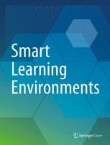Smart Learning Environments is affiliated with the International Association of Smart Learning Environments. This journal is supported by National Engineering Laboratory for Cyberlearning and Intelligent Technology and Smart Learning Institute of Beijing Normal University.
Automated labeling of PDF mathematical exercises with word N-grams VSM classification
In recent years, smart learning environments have become central to modern education and support students and instructors through tools based on prediction and recommendation models. These methods often use le...

